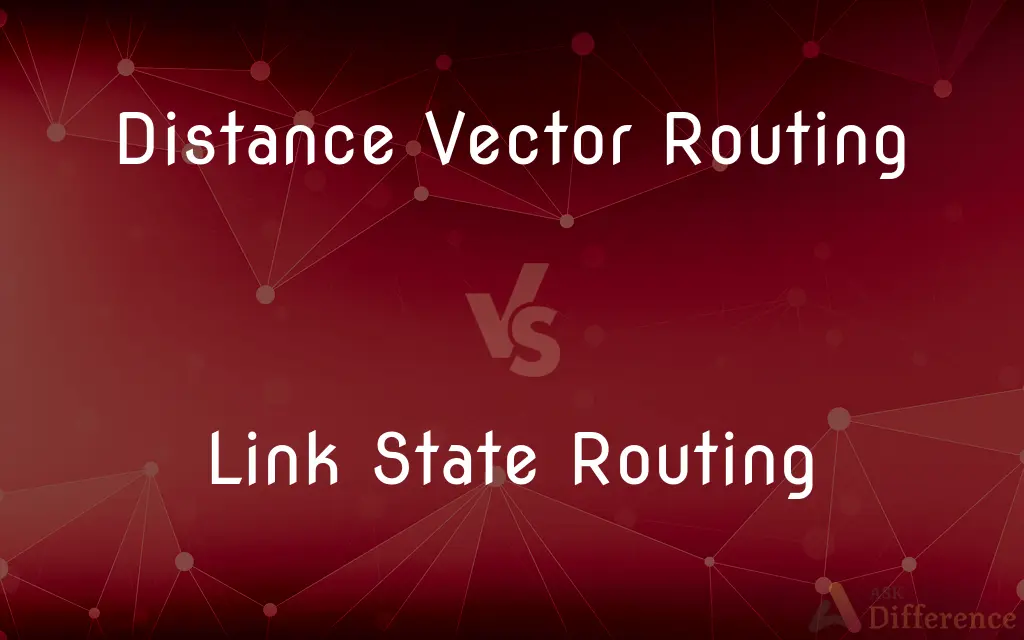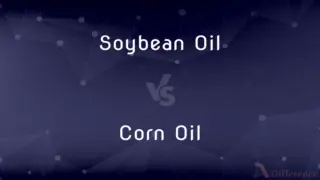Distance Vector Routing vs. Link State Routing — What's the Difference?
By Tayyaba Rehman — Published on January 2, 2024
Distance Vector Routing relies on each node sharing its routing table with neighbors, focusing on the number of hops, while Link State Routing involves nodes sharing information about their entire network topology, focusing on the state of each link.

Difference Between Distance Vector Routing and Link State Routing
Table of Contents
ADVERTISEMENT
Key Differences
Distance Vector Routing uses a method where each router shares its routing table only with its immediate neighbors, and the information is updated periodically. In Link State Routing, each router has a complete map of the network topology and updates are shared with all routers in the network.
Distance Vector Routing is based on the Bellman-Ford algorithm and primarily considers the number of hops to determine the best path. Link State Routing uses Dijkstra's algorithm and takes into account the state of each link, including bandwidth and congestion.
In Distance Vector Routing, the simplicity of the protocol makes it easier to implement but can lead to slower convergence and issues like routing loops. Link State Routing, while more complex, offers faster convergence and greater stability.
Distance Vector Routing is generally more suitable for smaller, less complex networks due to its lower overhead. Link State Routing is preferred in larger, more dynamic networks for its accuracy and scalability.
Updates in Distance Vector Routing propagate gradually from one node to its neighbors and then further, which can delay overall network awareness. Link State Routing achieves quicker network-wide awareness due to its comprehensive broadcasting of updates.
ADVERTISEMENT
Comparison Chart
Routing Information
Shared only with immediate neighbors.
Shared with all routers in the network.
Algorithm Used
Based on the Bellman-Ford algorithm.
Uses Dijkstra's algorithm.
Focus
Number of hops to reach a destination.
State of each link, including quality and bandwidth.
Network Suitability
Better for smaller, less complex networks.
Preferred in larger, more dynamic networks.
Convergence and Stability
Slower convergence, potential for routing loops.
Faster convergence, higher stability.
Compare with Definitions
Distance Vector Routing
Distance Vector Routing involves routers sharing routing tables with their direct neighbors.
Each router in the Distance Vector Routing protocol periodically sends its routing table to adjacent routers.
Link State Routing
Link State Routing creates a complete network topology map at each router.
Link State Routing was used to ensure each router had a full view of the network layout.
Distance Vector Routing
The protocol is characterized by its hop count metric for route selection.
Distance Vector Routing selects the path with the fewest hops to the destination.
Link State Routing
It uses Dijkstra's algorithm to determine the shortest path through the network.
The network's optimal paths were calculated using Dijkstra's algorithm in the Link State Routing process.
Distance Vector Routing
Distance Vector Routing calculates the best path based on the distance to destination nodes.
In our small network, we implemented Distance Vector Routing for its simplicity and lower overhead.
Link State Routing
This protocol provides faster convergence and avoids routing loops.
The quick convergence of Link State Routing minimized disruptions during network changes.
Distance Vector Routing
Distance Vector Routing can be prone to issues like count-to-infinity problems.
We had to address the count-to-infinity problem inherent in the Distance Vector Routing protocol.
Link State Routing
Link State Routing is preferred for larger, more complex networks.
Due to our network's size, we opted for Link State Routing for better efficiency and scalability.
Distance Vector Routing
It is suitable for smaller networks due to its relatively simple implementation.
For our branch office network, Distance Vector Routing was the ideal choice.
Link State Routing
Link State Routing considers the quality and bandwidth of network links.
Link State Routing helped in efficiently managing the network traffic by considering link bandwidth.
Common Curiosities
How does Link State Routing prevent routing loops?
It prevents loops through comprehensive network awareness and advanced algorithms.
Which routing protocol is easier to configure?
Distance Vector Routing is generally easier to configure.
Is Distance Vector Routing suitable for large networks?
It's less suitable for large networks due to slower convergence and scalability issues.
Can Distance Vector Routing adapt to changing network topologies?
It can adapt but generally slower than Link State Routing.
Can Link State Routing handle network changes more effectively?
Yes, Link State Routing is more effective in handling dynamic network changes.
Do Distance Vector protocols require more bandwidth?
They can be less efficient in bandwidth usage compared to Link State protocols.
Does Link State Routing offer faster recovery from network failures?
Yes, it typically offers faster recovery due to quicker convergence.
Can Distance Vector Routing scale well with network growth?
It faces challenges scaling with larger networks.
Is Link State Routing more CPU intensive?
Yes, due to its complexity and the use of Dijkstra's algorithm.
How often do routers update in Distance Vector Routing?
Updates are periodic and can vary based on the specific protocol implementation.
Are Link State protocols more secure?
They can offer better security features and more controlled routing updates.
Does Distance Vector Routing require more maintenance?
It may require more maintenance in dynamic or large networks.
What is the primary metric used in Distance Vector Routing?
The primary metric is usually the number of hops.
Is OSPF a Distance Vector or Link State protocol?
OSPF (Open Shortest Path First) is a Link State protocol.
What kind of networks is Link State Routing best suited for?
It's best suited for large, complex, and rapidly changing networks.
Share Your Discovery

Previous Comparison
Supervised Learning vs. Unsupervised Learning
Next Comparison
Soybean Oil vs. Corn OilAuthor Spotlight
Written by
Tayyaba RehmanTayyaba Rehman is a distinguished writer, currently serving as a primary contributor to askdifference.com. As a researcher in semantics and etymology, Tayyaba's passion for the complexity of languages and their distinctions has found a perfect home on the platform. Tayyaba delves into the intricacies of language, distinguishing between commonly confused words and phrases, thereby providing clarity for readers worldwide.













































